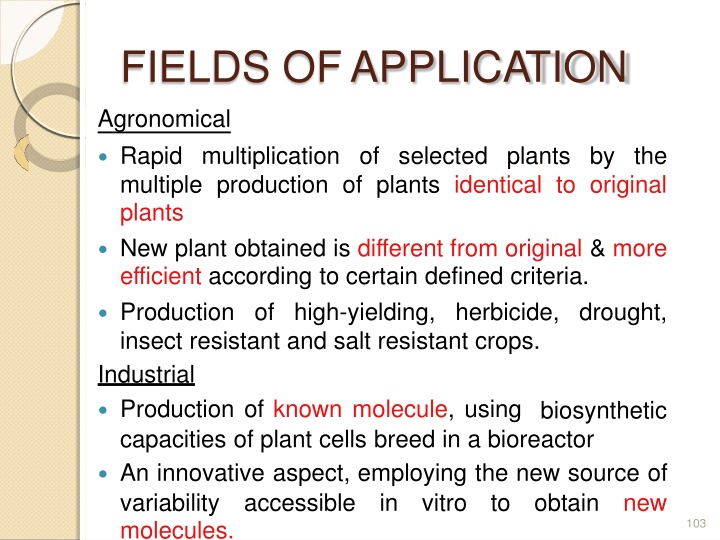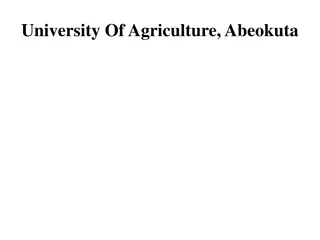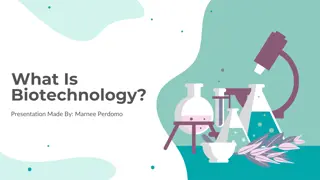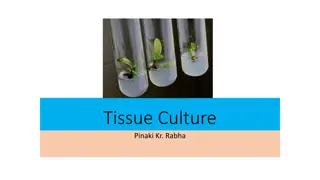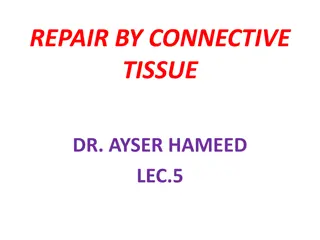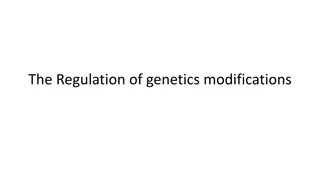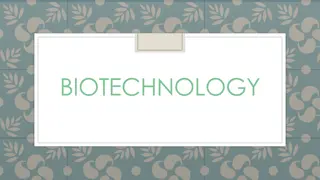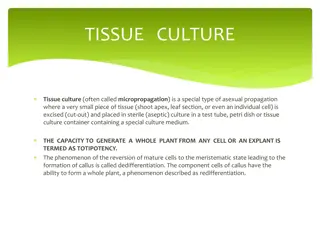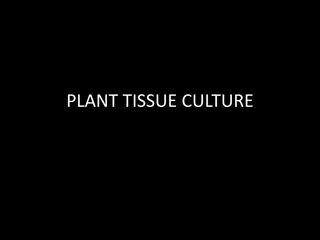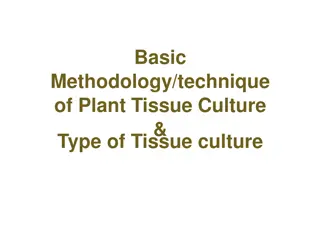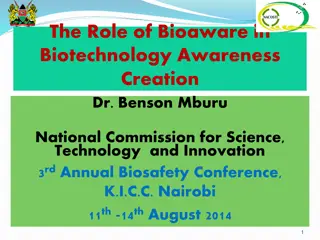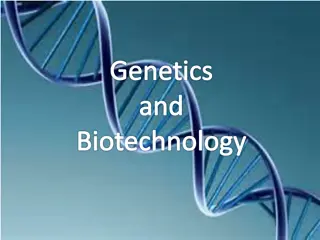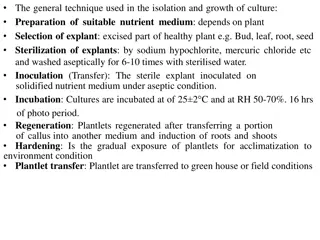Plant Tissue Culture Applications in Agriculture and Biotechnology
Plant tissue culture technology is a versatile tool used in agronomy and biotechnology for rapid multiplication of selected plants, production of high-yielding, herbicide, drought, insect, and salt-resistant crops, as well as the generation of phytopharmaceuticals, secondary metabolites, and novel compounds. The technique enables plant improvement, genetic transformation, biotransformation, and the study of plant metabolism, offering innovative solutions for plant research and crop production.
Download Presentation

Please find below an Image/Link to download the presentation.
The content on the website is provided AS IS for your information and personal use only. It may not be sold, licensed, or shared on other websites without obtaining consent from the author.If you encounter any issues during the download, it is possible that the publisher has removed the file from their server.
You are allowed to download the files provided on this website for personal or commercial use, subject to the condition that they are used lawfully. All files are the property of their respective owners.
The content on the website is provided AS IS for your information and personal use only. It may not be sold, licensed, or shared on other websites without obtaining consent from the author.
E N D
Presentation Transcript
FIELDS OFAPPLICATION Agronomical Rapid multiplication of selected plants by the multiple plants New plant obtained is different from original efficient according to certain defined criteria. Production of high-yielding, herbicide, drought, insect resistant and salt resistant crops. Industrial Production of known molecule, using biosynthetic capacities of plant cells breed in a bioreactor An innovative aspect, employing the new source of variability accessible molecules. production of plants identical to original & more in vitro to obtain new 103
Application of plant tissue culture Plant tissue culture technology has been used in almost all the field of biosciences. Its applications include Production of phytopharmaceuticals and secondary metabolites. 1. a) b) c) d) Elicitors 2. 3. 4. 5. 6. 7. 8. 9. 10. Plant improvement by studying diseases of plant and their elimination with the help of plant tissue culture. Mutant cell selection is done by addition of toxic substance to cells followed by isolation of resistant cells. Production of economical valuable chemicals by plant tissue culture which are not possible by other chemical methods. Biotransformation (Biochemical Conversion) Plant cell immobilization Genetic transformation (Transgenic plant) Micropropagation (Clonal Propagation) Synthetic seed Protoplast culture and somatic hybridization Hairy root culture Cryopreservation Tracing the biosynthetic pathways of secondary metabolites Generation novel compound from plant Respiration, organ function and metabolism in plant tissue culture can be studied. 11. 12. 104
1. Production of phytopharmaceuticals and secondary metabolites Secondary plant metabolites like alkaloids, terpenoids, flavonoids, lipids, oils, tannins, anthraquinones, flavones, napthaquinones, vitamins, proteins, anticancer agents, antiviral agents etc. few phytopharmaceuticals culture. Compound Anthraquinones Cassia angustifolia Caffeine Cardenolides Digitalis purpurea are or isolated from plant tissue culutre. Following table list secondary metabolities derived from plant tissue Plant species Culture type Callus Callus Suspension & Callus Suspension Callus Suspension Callus Suspension Callus & Suspension Suspension Callus Suspension Suspension Coffee arabica Codeine Diosgenin Glycyrrhizin Papain Reserpine Rosmarinic acid Papaver somniferum Dioscorea composita Glycyrrhiza glabra Carica papaya Rauwolfia serpentina Coleus blumei Trigonelline Vinblastine Visnagin Xanthotoxin Trigonella foenum-graecum Catharanthus roseus Ammi visnaga Ruta graveolens 105
a) It is a process through which the functional group of compounds are modified by living cells. Biotransformation (Biochemical Conversion) organic Chemical conversion by living cell culture Chemically different product Substrate This process can be done by using microorganism or plant cell suspension, hairy root culture and immobilized cell. Biotransformation by plant cell cultures yield a wide range of reactions, such as glycosylation, hydroxylation, isomerisation, methylation, demethylation and dehydrogenation etc. It not only increases the yield but also very economical for commercial production. Few examples of biotransformation are as follows: glucosyleserification, hydrolysis, oxido-reductions, epoxidation, 106
Class Substrate Codeinone Product codeine Plant Alkaloids Papaver somniferum Datura innoxia Digitalius Lanata Datura innoxia, Catharanthus roseus Perilla frutescens phenolics Steroids Phenolic flavonoids resorcinol Digitoxin liquiritigenin Glucoside glucoside digoxin Rhein Glucoside Phenolic anthraquinon es Phenolic courmarins Umbelliferone- 7-glucoside Umbellifero ne Datura innoxia, Catharanthus roseus Lavandula angustifolia terpenoids Citral Citrol 107
b) Plant cell Immobilization It is defined as a technique, which confines to a catalytically active enzyme (or to a cell) with in a reactors system and prevents its entry into the mobile phase, which carries the substrate and product. It involves the entrapment of cells within a gel or passive adsorption on solid support materials, thus creating a situation for cell to imitate membership on a tissue of a whole plant. Immobilized non-growing cells Product Substrate It is a controlled process of agglutination, formation and adhesion on a matrix under controlled condition. It is a process in which highly reactive and sensitive enzyme is embedded in a matrix so that only substance and product can pass through matrix. Cells cease to grow & accumulate metabolites. In immobilization technique the plant cells are entrapped in different polymerize matrices. E.g. alginate, agar, agarose etc. and converted into hetrogeneouscatalyst. 108
Different types of immobilization are 1. Adsorption-Direct intracellular binding due to natural affinity (adhesion or agglutination) Covalent linkage-Covalentcoupling on otherwise inert matrices. Cross linking-Intracellular connection via bi or poly functional reagent Embedding-Mixingwith suitable materials by changing their consistencywith temperature. Entrapment-Physical retention within the frame work of diverse pore size and permeability (Micro encapsulation) Mechanism/methods of immobilization system 1. Entrapment a.Gel entrapment by polymerization polyacrylamide e.g. vinca b.Gel entrapment by ionic network formation: Entrapment of cell in calcium alginate 2. 3. 4. 5. with polymers like 109
c. Gel entrapment by formation by precipitation of some polymer by changing one or more parameters such salinity etc. Entrapment in performed structures like hollow fibre reactors e.g. Polyurethane foam. Surface immobilization with help of nylon, cellulose etc. Immobilization by embedding in agar, agarose etc. natural and synthetic as pH, temperature, d. 2. 3. Applications of plant cell immobilization: Biotransformation Rapid biosynthesis of secondary metabolites Synthesis from precursor The biosynthesis of secondary metabolites with increased period of time. yield over extended Examples: Immobilization of various plant like Capsicum, Coffee, Vinca, Mentha, Tobacco etc. 110
c) The plants obtained through genetic engineering contain a gene usually from an unrelated organism, such genes are called transgenes, and the plants containing transgenes are called as transgenic plants. Genetic transformation can be defined as the transfer of foreign genes (DNA) or the recombinant DNA isolated from plants, viruses bacteria into a new genetic background. The targeted cells for gene transformation are cultured cells or protoplast, meristem cells from embryos, pollens, zygote and cells from immature embryos, shoots and flowers. Application Genes have been successfully transferred to many crops for resistance to various biotic stresses Genes resistant to abiotic stresses like herbicide resistance Resistance against viral infection Gene transfers to improve quality of food products Male sterility and fertility restoration in transgenic plants Transgenic plants have both basic and applied role in crop improvement. E.g. Tobacco, tomato, soybean, Satavari, papaya, liquorice, neem etc. Genetic transformation (Transgenic plant) 111
d) Elicitors are organic/inorganic agents used in tissue culture to trigger rapid and increase production of secondary metabolites or rapid growth of plant cell culture/organs. Induction of stress in plant cultures in terms of specific environmental, physiological & biological conditions, to enhance the production of secondary metabolites, is known as Elicitation. The secondary compounds synthesized & accumulated in response to such conditions are called Phytoalexins , which act as defense agent to invading pathogens. The signals triggering the formation of phytoalexins are called elicitors. Elicitors Classification of Elicitors A. Based on Origin 1. Exogenous elicitors: Enzymes, metal ions, U.V . Light, chitosan etc. 2. Endogenous elicitors: Hepta- -glucoside, Dodeca -1,4 D-galacturonide etc. Based on nature B. 1. 2. Abiotic elicitors Biotic elicitors 112
1. Biotic elicitors They are derived from microorganisms or produced within the plant cells by plant defensive process against microbial infection. They include mainly -Linked glucans, chitosan, enzymes, cell wall derived polysaccharides like pectin, pectic acid, cellulose, etc. These elicitors when added to medium in low concentration (50- 250ng/l) enhance metabolite production. 2. Abiotic elicitors Product accumulation also occurs under stress caused by physical or chemical agents like UV , low or high temperature, antibiotics, salts of heavy metals, freezing and thawing cycles, non-essential components of media (agarose, tin, and agaropectin), certain chemicals (methyl jasmonate, copper sulphate, silver nigtrate etc.), and high salt concentration grouped under abiotic elicitors. Elicitors stimulated the accumulation of secondary metabolites in different plant culture like Opium, Dioscorea, Datura, Vinca, Capsicum, Carrot etc. 113
2. Micropropagation (Clonal propagation) Micropropagation or Clonal propagation is a field dealing with the ability to regenerate plants directly from explants or from a single individual by asexual reproduction, constitute a clone. It is defined as True-to-type propagation of selected genotypes using in vitro culture techniques. V egetative method of propagating plant is termed as micropropagation or cloning tissue culture or growing in vitro. Methods of Micropropagation are as follows: a) b) c) d) Plant regeneration by organogenesis from callus and cell suspension cultures. Plant regeneration from callus and cell suspension culture by somatic embryogenesis. f) Direct (adventitious) somatic embryogenesis) Micropropagation by proliferation of axillary buds Adventitious shoot proliferation Artificial seed. e) embryogenesis (Non-zygotic 114
Advantages maintenance characters in hybirds and improvement of plant by developing virus-free, insect-resistant, disease resistant, herbicide-resistant plant. of of a short period of time, multiplication of sexually derived sterile this method is rapid multiplication of superior clones, genetic uniformity, high yielding crops of the desirable Example: Fennel is genetically heterozygous and produces wide variation in oil yield and composition. Also various plants like Garlic, Brahmi, Vinca, Eucalyptus, technique. Gymnema, Liquorice etc. are propagation by this 115
3. Synthetic seed (Artificial seed or Somatic seed or Synerts or Synseed) Synthetic seeds are defined as artificially encapsulated somatic embryos, shoot buds, cell aggregates or any other tissue that can be used for sowing a seed and that possess the ability to convert into a plant under in vitro or ex vitro conditions and that retain this potential also after storage. V arious plant species which are reported for artificial seed production are Carrot, Alfa alfa (somatic embryos), Banana, Cardamom (Shoot buds or shoot tips), Ecalyptus (Axillary buds) etc. They are classified as Desiccated and Hydrated. These two are again classified into encapsulated and uncoated. The desiccated synthetic seeds are produced from somatic embryos either naked or encapsulated in polyoxy ethylene glycol followed by their desiccation. E.g. Wheat, Soyabean (Uncoated), Carrot (Encapsulated) Hydrated synthetic seeds are produced in those plant species where somatic embryos are recalcitrant and sensitive to desiccation. Hydrated seeds are produced by encapsulating the somatic embryos or somatic propagules in hydrogel capsules. E.g. Carrot, tomato (Uncoated), Mango, Alfa alfa (Encapsulated) 116
Applications of synthetic seeds 1. 2. 3. Micropropagation through artificial seeds. For development of plants for breeding purpose Propagation of variety of crop plants especially crops for which true seeds are not used or not readily available for multiplication or the true seeds are expensive. Hybrid plants may vegetatively propagated plants which are prone to infections e.g. Garlic, potato, tomato, hybrid rice etc. Transplanting improved or selected material in forestry to reduce the cost of breeding e.g. European larch, white spruce etc. Germplasm conservation of endangered species of synseeds in near future. 4. 5. through cryopreservation 4. Protoplast culture and somatic Already discussed before hybridization 5. Hairy root culture Already discussed before 117
6. Cryopreservation The preservation of cell, tissue and organs in liquid nitrogen is called cryopreservation and the science pertaining to this activity is known as cryobiology. Cryopreservation is the non-lethal storage of biological material at ultra low temperature. At the temperature of liquid nitrogen (-196 C) almost all the metabolic activities of cells are ceased and the sample can then be preserved in such state for extended periods. However, only few biological materials can be frozen to (-196 C) without affecting the cell viability. Cryopreservation of few endangered medicinal plants e.g. Dioscorea, Chirata, Podophyllum etc. is done these days. 118
7. Tracing metabolites Tissue culture can be used for tracing the biosynthetic pathways of secondary metabolites using labelled precursor in the culture medium. 8. Generation novel compounds from plant By various methods of plant tissue culture isolation of novel compound and improvement compound can be achieved. Respiration, organ function and culture can be studied. Plant improvement by studying elimination with the help of plant 11. Mutation and selection of the mutant cell is done for significant contribution to new genetic variability. Production of economical valuable chemicals by plant tissue culture which are not possible by other chemical methods. the biosynthetic pathways of secondary in yield of the existing 9. metabolism in plant tissue 10. diseases of plant and their tissue culture. 12. 119
